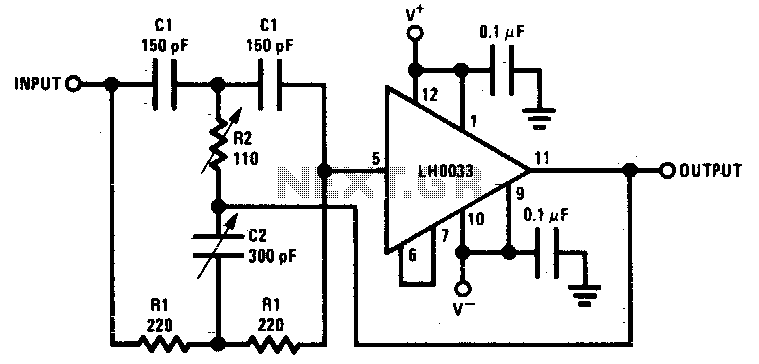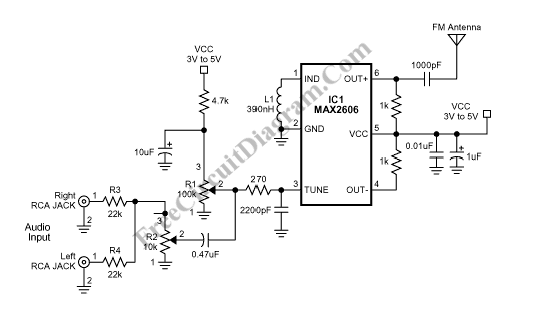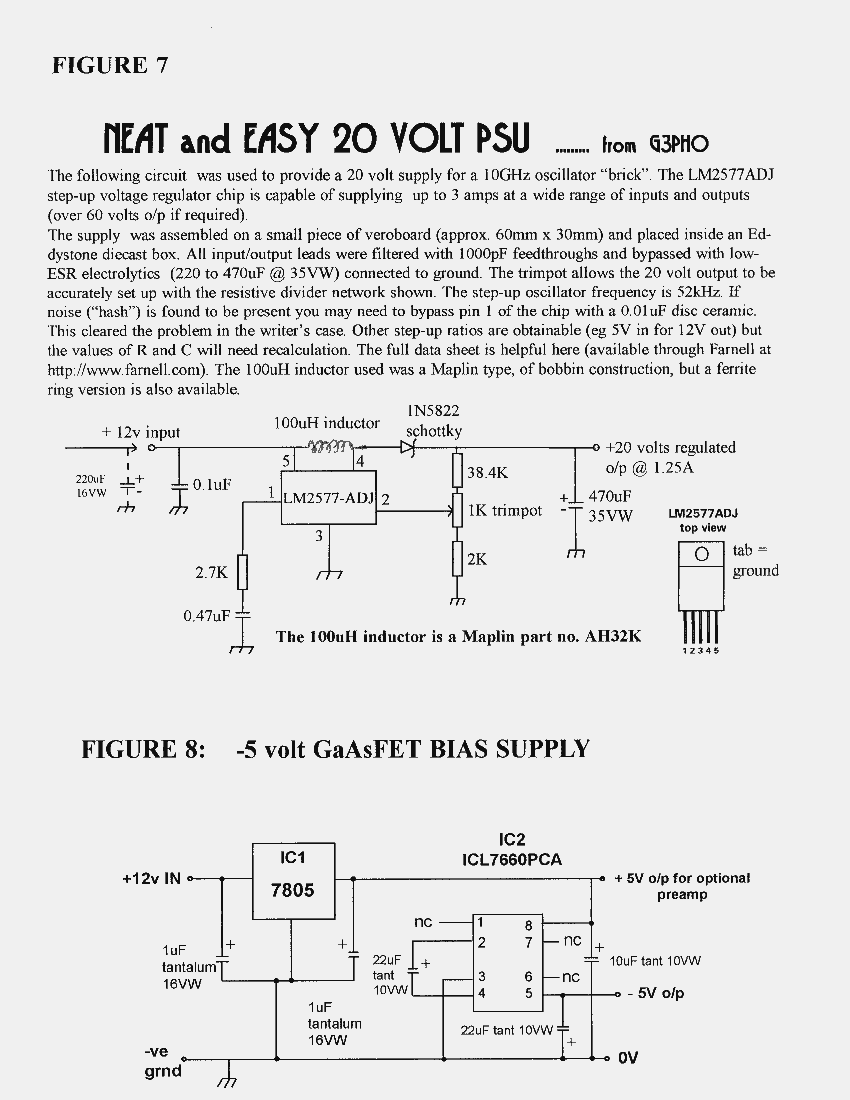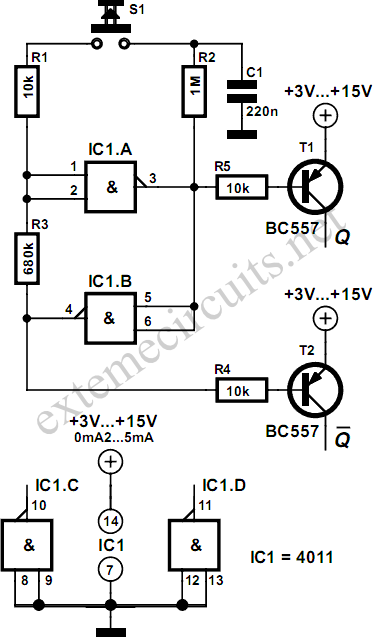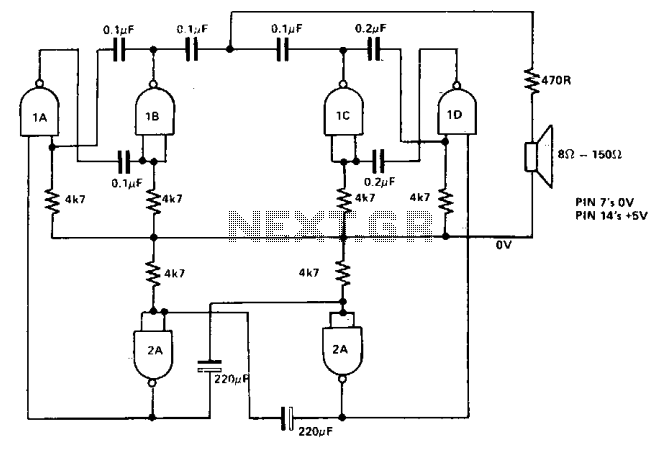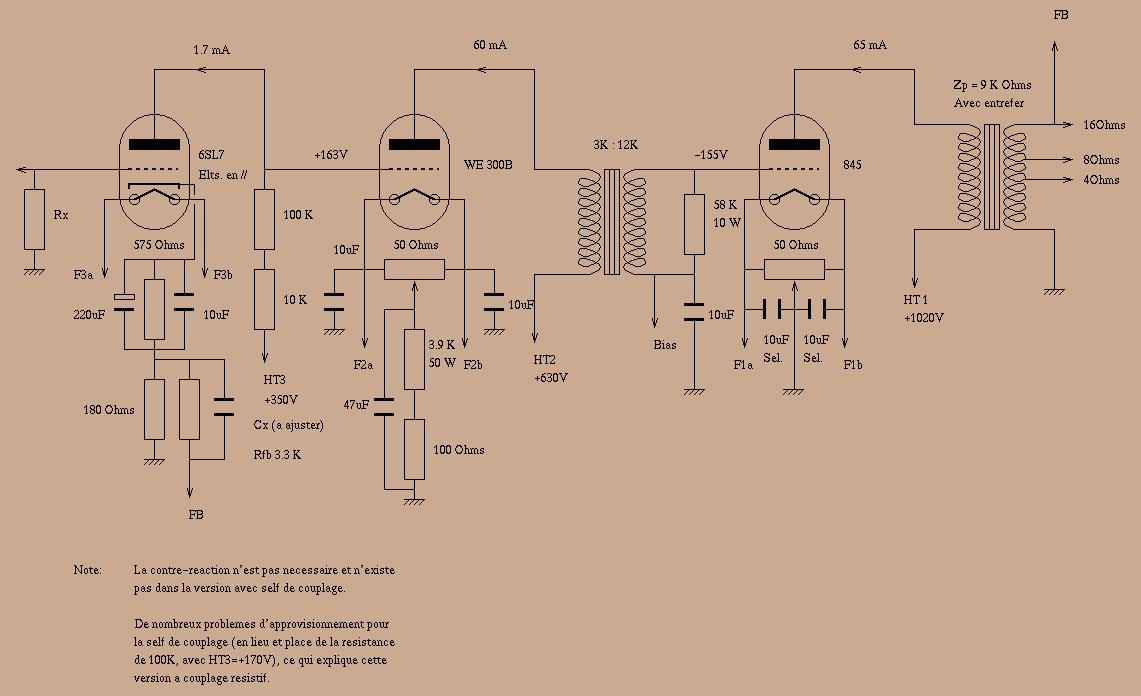
The NOT gate
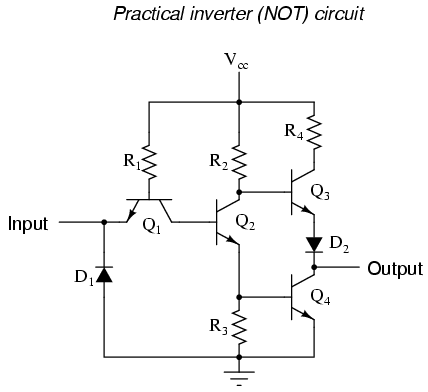
The single-transistor inverter circuit discussed earlier is too simplistic for practical use as a gate. Real inverter circuits utilize multiple transistors to enhance voltage gain, ensuring that the final output transistor is either in full cutoff or full saturation, while also incorporating additional components to minimize the risk of accidental damage. This circuit consists solely of resistors and bipolar transistors. It is important to note that alternative circuit designs can achieve the NOT gate function, including configurations that replace bipolar transistors with field-effect transistors, which will be addressed later in this chapter.
To analyze this circuit under the condition where the input is "high," or in a binary "1" state, the input terminal can be connected to Vcc through a switch. In this scenario, diode D1 will be reverse-biased and will not conduct any current. The inclusion of D1 in the circuit serves to protect the transistors from damage in the event of a negative voltage being applied to the input (a voltage that is negative relative to ground). With no voltage applied between the base and emitter of transistor Q1, it would be expected that no current would flow through it. However, Q1 operates differently in this circuit, functioning as a back-to-back pair of diodes.
The purpose of these diodes is to direct current to or away from the base of transistor Q2, depending on the input logic level. Understanding how these two diodes "steer" current may require an illustrative example. Consider a diode/resistor circuit that represents the base-emitter junctions of transistors Q2 and Q4 as single diodes, allowing for a focused analysis of the current "steered" through the back-to-back diodes. When the input switch is in the "up" position (connected to Vcc), it is evident that there will be no current through the left steering diode of Q1, as there is no voltage across the switch-diode-R1-switch loop to drive electron flow. However, current will flow through the right steering diode of Q1, as well as through the base-emitter junctions of Q2 and Q4. This indicates that in the actual gate circuit, transistors Q2 and Q4 will receive base current, allowing them to conduct collector current.
The total voltage drop between the base of Q1 (the node connecting the two back-to-back steering diodes) and ground will be approximately 2.1 volts, which corresponds to the combined voltage drops of three PN junctions: the right steering diode, Q2's base-emitter diode, and Q4's base-emitter diode. If current were measured in this circuit, it would be observed that all current flows through the left steering diode of Q1, with none passing through the right diode. This raises the question of why there appears to be a complete path for current through the diodes of Q4 and Q2, the right diode of the pair, and resistor R1, yet no current flows through that path.
The explanation lies in the nonlinear characteristics of PN junction diodes; they do not conduct current until a certain forward voltage is applied, which is approximately 0.7 volts for silicon diodes and 0.3 volts for germanium diodes. Once they begin conducting, they maintain a voltage drop of about 0.7 volts. When the switch is in the "down" position, the left diode of the steering diode pair conducts fully, dropping approximately 0.7 volts across it. In contrast, with the switch in the "up" position (where transistors Q2 and Q4 are conducting), a total of about 2.1 volts is dropped across the relevant components, illustrating the circuit's operation and the role of each component in the logic gate function.The single-transistor inverter circuit illustrated earlier is actually too crude to be of practical use as a gate. Real inverter circuits contain more than one transistor to maximize voltage gain (so as to ensure that the final output transistor is either in full cutoff or full saturation), and other components designed to reduce the chance of acc
idental damage. This circuit is composed exclusively of resistors and bipolar transistors. Bear in mind that other circuit designs are capable of performing the NOT gate function, including designs substituting field-effect transistors for bipolar (discussed later in this chapter). Let`s analyze this circuit for the condition where the input is "high, " or in a binary "1" state. We can simulate this by showing the input terminal connected to Vcc through a switch: In this case, diode D1 will be reverse-biased, and therefore not conduct any current.
In fact, the only purpose for having D1 in the circuit is to prevent transistor damage in the case of a negative voltage being impressed on the input (a voltage that is negative, rather than positive, with respect to ground). With no voltage between the base and emitter of transistor Q1, we would expect no current through it, either.
However, as strange as it may seem, transistor Q1 is not being used as is customary for a transistor. In reality, Q1 is being used in this circuit as nothing more than a back-to-back pair of diodes. The following schematic shows the real function of Q1: The purpose of these diodes is to "steer" current to or away from the base of transistor Q2, depending on the logic level of the input.
Exactly how these two diodes are able to "steer" current isn`t exactly obvious at first inspection, so a short example may be necessary for understanding. Suppose we had the following diode/resistor circuit, representing the base-emitter junctions of transistors Q2 and Q4 as single diodes, stripping away all other portions of the circuit so that we can concentrate on the current "steered" through the two back-to-back diodes: With the input switch in the "up" position (connected to Vcc), it should be obvious that there will be no current through the left steering diode of Q1, because there isn`t any voltage in the switch-diode-R1-switch loop to motivate electrons to flow.
However, there will be current through the right steering diode of Q1, as well as through Q2`s base-emitter diode junction and Q4`s base-emitter diode junction: This tells us that in the real gate circuit, transistors Q2 and Q4 will have base current, which will turn them on to conduct collector current. The total voltage dropped between the base of Q1 (the node joining the two back-to-back steering diodes) and ground will be about 2.
1 volts, equal to the combined voltage drops of three PN junctions: the right steering diode, Q2`s base-emitter diode, and Q4`s base-emitter diode. If we were to measure current in this circuit, we would find that all of the current goes through the left steering diode of Q1 and none of it through the right diode.
Why is this It still appears as though there is a complete path for current through Q4`s diode, Q2`s diode, the right diode of the pair, and R1, so why will there be no current through that path Remember that PN junction diodes are very nonlinear devices: they do not even begin to conduct current until the forward voltage applied across them reaches a certain minimum quantity, approximately 0. 7 volts for silicon and 0. 3 volts for germanium. And then when they begin to conduct current, they will not drop substantially more than 0. 7 volts. When the switch in this circuit is in the "down" position, the left diode of the steering diode pair is fully conducting, and so it drops about 0.
7 volts across it and no more. Recall that with the switch in the "up" position (transistors Q2 and Q4 conducting), there was about 2. 1 volts dropped between those same two poin 🔗 External reference
To analyze this circuit under the condition where the input is "high," or in a binary "1" state, the input terminal can be connected to Vcc through a switch. In this scenario, diode D1 will be reverse-biased and will not conduct any current. The inclusion of D1 in the circuit serves to protect the transistors from damage in the event of a negative voltage being applied to the input (a voltage that is negative relative to ground). With no voltage applied between the base and emitter of transistor Q1, it would be expected that no current would flow through it. However, Q1 operates differently in this circuit, functioning as a back-to-back pair of diodes.
The purpose of these diodes is to direct current to or away from the base of transistor Q2, depending on the input logic level. Understanding how these two diodes "steer" current may require an illustrative example. Consider a diode/resistor circuit that represents the base-emitter junctions of transistors Q2 and Q4 as single diodes, allowing for a focused analysis of the current "steered" through the back-to-back diodes. When the input switch is in the "up" position (connected to Vcc), it is evident that there will be no current through the left steering diode of Q1, as there is no voltage across the switch-diode-R1-switch loop to drive electron flow. However, current will flow through the right steering diode of Q1, as well as through the base-emitter junctions of Q2 and Q4. This indicates that in the actual gate circuit, transistors Q2 and Q4 will receive base current, allowing them to conduct collector current.
The total voltage drop between the base of Q1 (the node connecting the two back-to-back steering diodes) and ground will be approximately 2.1 volts, which corresponds to the combined voltage drops of three PN junctions: the right steering diode, Q2's base-emitter diode, and Q4's base-emitter diode. If current were measured in this circuit, it would be observed that all current flows through the left steering diode of Q1, with none passing through the right diode. This raises the question of why there appears to be a complete path for current through the diodes of Q4 and Q2, the right diode of the pair, and resistor R1, yet no current flows through that path.
The explanation lies in the nonlinear characteristics of PN junction diodes; they do not conduct current until a certain forward voltage is applied, which is approximately 0.7 volts for silicon diodes and 0.3 volts for germanium diodes. Once they begin conducting, they maintain a voltage drop of about 0.7 volts. When the switch is in the "down" position, the left diode of the steering diode pair conducts fully, dropping approximately 0.7 volts across it. In contrast, with the switch in the "up" position (where transistors Q2 and Q4 are conducting), a total of about 2.1 volts is dropped across the relevant components, illustrating the circuit's operation and the role of each component in the logic gate function.The single-transistor inverter circuit illustrated earlier is actually too crude to be of practical use as a gate. Real inverter circuits contain more than one transistor to maximize voltage gain (so as to ensure that the final output transistor is either in full cutoff or full saturation), and other components designed to reduce the chance of acc
idental damage. This circuit is composed exclusively of resistors and bipolar transistors. Bear in mind that other circuit designs are capable of performing the NOT gate function, including designs substituting field-effect transistors for bipolar (discussed later in this chapter). Let`s analyze this circuit for the condition where the input is "high, " or in a binary "1" state. We can simulate this by showing the input terminal connected to Vcc through a switch: In this case, diode D1 will be reverse-biased, and therefore not conduct any current.
In fact, the only purpose for having D1 in the circuit is to prevent transistor damage in the case of a negative voltage being impressed on the input (a voltage that is negative, rather than positive, with respect to ground). With no voltage between the base and emitter of transistor Q1, we would expect no current through it, either.
However, as strange as it may seem, transistor Q1 is not being used as is customary for a transistor. In reality, Q1 is being used in this circuit as nothing more than a back-to-back pair of diodes. The following schematic shows the real function of Q1: The purpose of these diodes is to "steer" current to or away from the base of transistor Q2, depending on the logic level of the input.
Exactly how these two diodes are able to "steer" current isn`t exactly obvious at first inspection, so a short example may be necessary for understanding. Suppose we had the following diode/resistor circuit, representing the base-emitter junctions of transistors Q2 and Q4 as single diodes, stripping away all other portions of the circuit so that we can concentrate on the current "steered" through the two back-to-back diodes: With the input switch in the "up" position (connected to Vcc), it should be obvious that there will be no current through the left steering diode of Q1, because there isn`t any voltage in the switch-diode-R1-switch loop to motivate electrons to flow.
However, there will be current through the right steering diode of Q1, as well as through Q2`s base-emitter diode junction and Q4`s base-emitter diode junction: This tells us that in the real gate circuit, transistors Q2 and Q4 will have base current, which will turn them on to conduct collector current. The total voltage dropped between the base of Q1 (the node joining the two back-to-back steering diodes) and ground will be about 2.
1 volts, equal to the combined voltage drops of three PN junctions: the right steering diode, Q2`s base-emitter diode, and Q4`s base-emitter diode. If we were to measure current in this circuit, we would find that all of the current goes through the left steering diode of Q1 and none of it through the right diode.
Why is this It still appears as though there is a complete path for current through Q4`s diode, Q2`s diode, the right diode of the pair, and R1, so why will there be no current through that path Remember that PN junction diodes are very nonlinear devices: they do not even begin to conduct current until the forward voltage applied across them reaches a certain minimum quantity, approximately 0. 7 volts for silicon and 0. 3 volts for germanium. And then when they begin to conduct current, they will not drop substantially more than 0. 7 volts. When the switch in this circuit is in the "down" position, the left diode of the steering diode pair is fully conducting, and so it drops about 0.
7 volts across it and no more. Recall that with the switch in the "up" position (transistors Q2 and Q4 conducting), there was about 2. 1 volts dropped between those same two poin 🔗 External reference
Warning: include(partials/cookie-banner.php): Failed to open stream: Permission denied in /var/www/html/nextgr/view-circuit.php on line 713
Warning: include(): Failed opening 'partials/cookie-banner.php' for inclusion (include_path='.:/usr/share/php') in /var/www/html/nextgr/view-circuit.php on line 713
